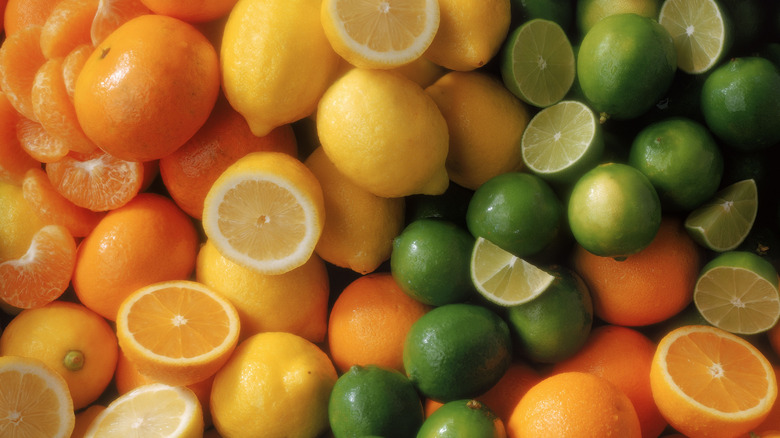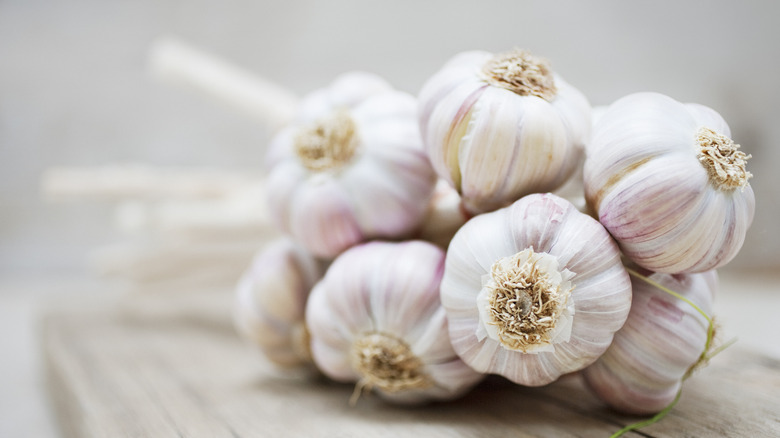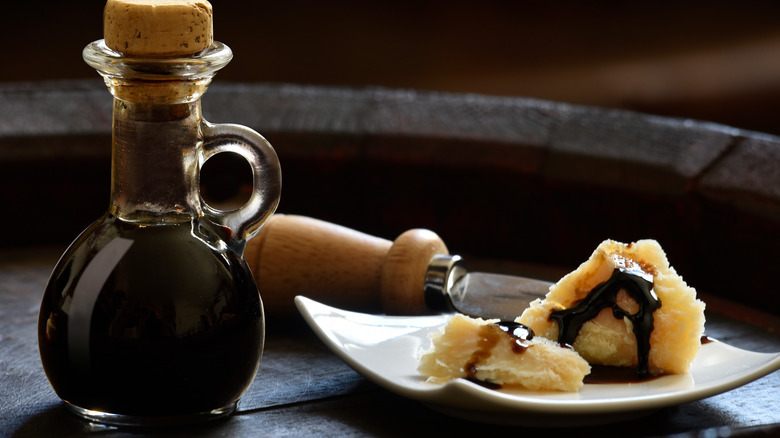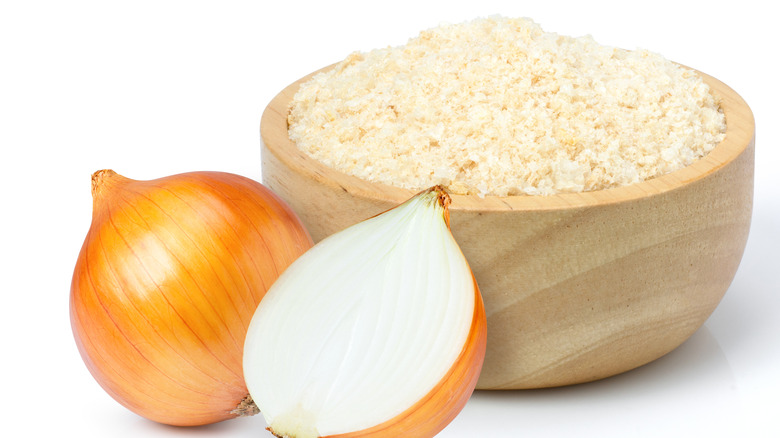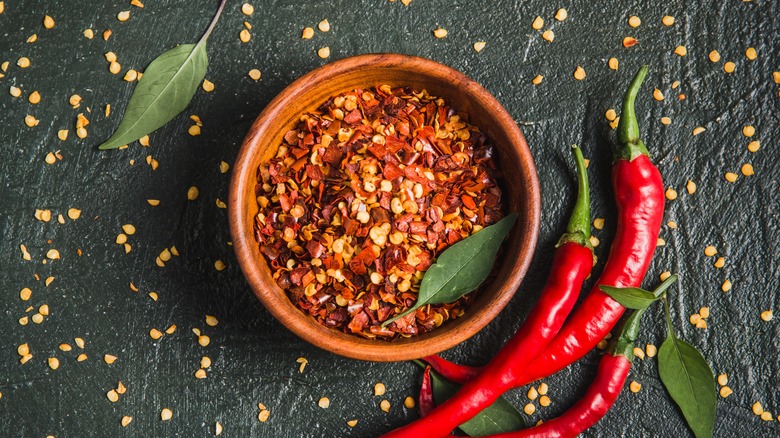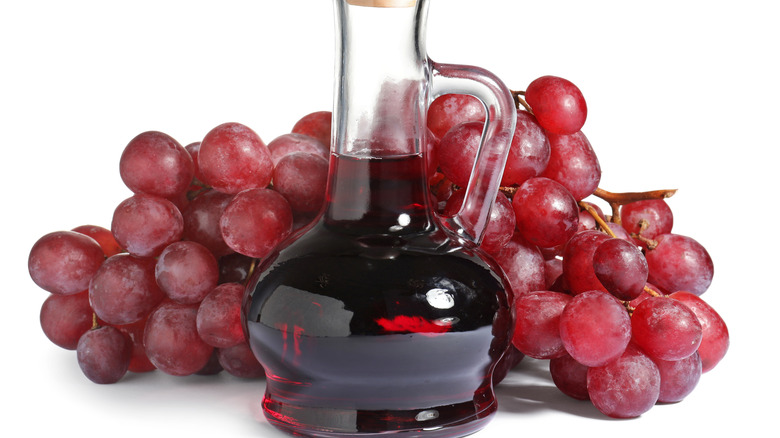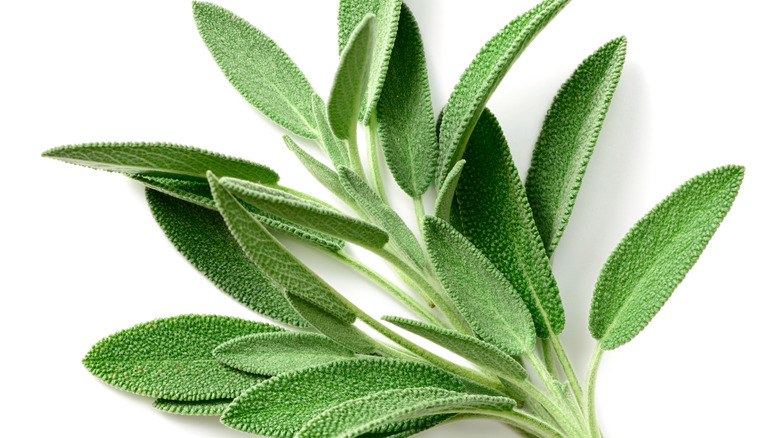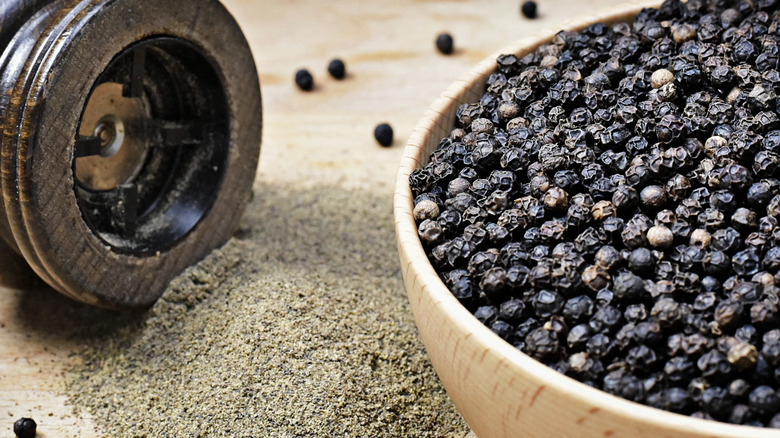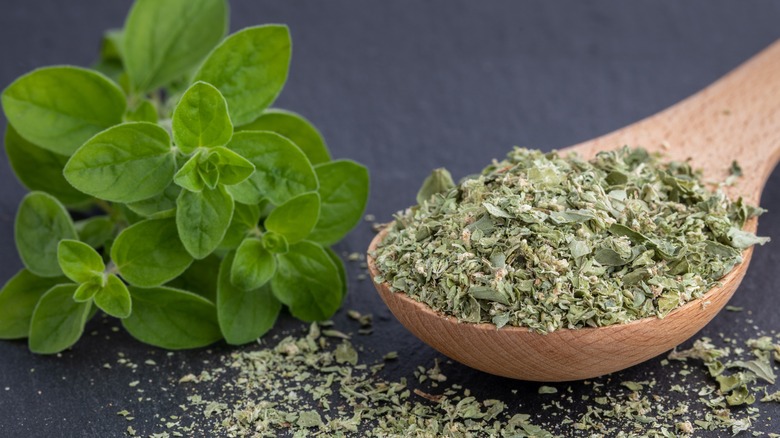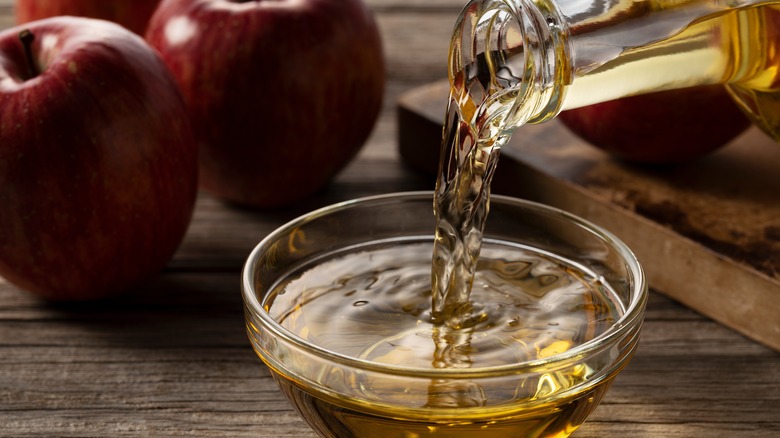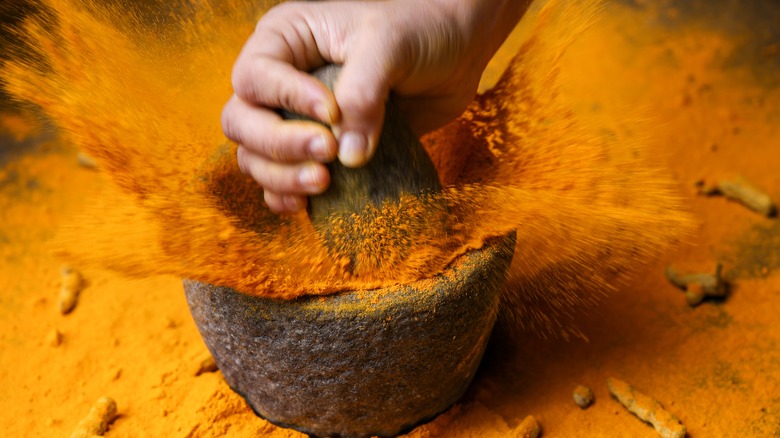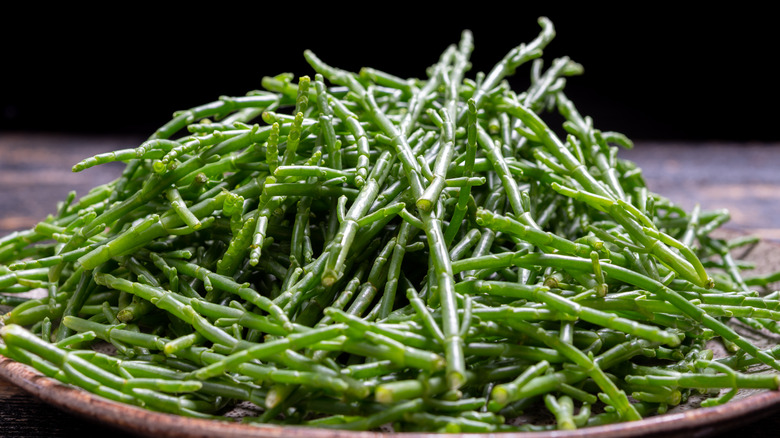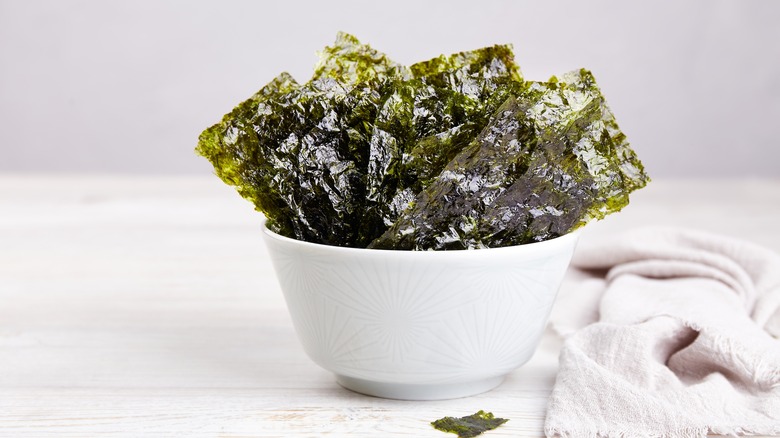13 Best Substitutes For Salt
Whether you're doing so for health reasons or just want to expand your flavor palette, reducing the amount of salt in your diet is often a good thing. Since just about every pre-packaged food comes loaded with sodium, your taste buds have likely adjusted to expecting this kind of high-salt level in your food, and it actually makes savoring the full flavor of a lightly salted meal difficult. Even if not for health reasons, it's a good idea to reset your taste buds occasionally by cutting back or eliminating salt. As you'll see, the difference in how you experience certain foods after a few weeks of a lower-sodium diet is rather amazing.
Foods you previously craved will taste almost too salty (the same can happen with sugar). It is not to say you should fully eliminate sodium from your diet, as it does help deliver electrolytes to the rest of your body, not to mention replenishing the salt you lose after working out. In moderation, salt has a place in your daily dietary requirements. Beyond your health and well-being, salt is a critical seasoning in most dishes. But what can you do to enhance your food without grabbing the salt shaker? Here are a few suggestions.
1. A squirt of lemon or lime
There's a reason why so many restaurants, both high-end and food stands, offer up a slice of lemon or lime with your seafood. It's not just a fancy garnish adding a burst of color. It is because that little squirt of fresh citrus brings the food alive in ways nothing else can. And the good thing is, a squirt of citrus doesn't need to stop at seafood. It's great for rice dishes, soups, and just about anything.
According to the Seattle Times, lemons and limes work similarly to salt. The taste receptors on your tongue experience salty and sour tastes by increasing saliva production. Essentially, it flips a switch in your brain, which helps heighten your tastebuds and improve your culinary eating experience. Salt is easier and far more affordable to have in stock and on a kitchen table, but a squirt of lemon or lime juice will work in a nearly identical way.
Additionally, a major benefit to sour citrus is it helps give your food a fresher, clean taste. Citrus also will work at "cooking" raw foods. Most ceviche, a raw seafood dish, is made using citrus, in which high acidic levels cook the food. So elevate your next meal while cutting out salt by swapping in a few squirts of lemon or lime. If it works in otherwise poor-tasting lager beers, you better believe it will work to enhance your already delicious meal.
2. Garlic
If there is such a thing as too much garlic, we haven't heard of it. Garlic is fantastic in that it helps transform and increase the flavors of everything around it. Now, unlike salt, it isn't neutral, so adding garlic will change the flavor profile of your meal. But if you are looking for a delicious way to swap out salt without turning your dinner into something dreary and drab, garlic is the way to go.
It is important to point out how garlic affects your taste buds. It works a little differently than salt, but it does invite your tongue to the flavor party, so it's best to prepare yourself. As The New York Times points out, garlic works in a similar way as chili and horseradish. While it won't give you that sinus burns you experience after dunking sushi in too much wasabi and soy sauce, it will light a bit of a flavor fire. Ever seen videos of people swallowing a large amount of garlic powder? If you have, you already know that's a check their tongue can't cash because, despite not being "spicy," it will make your mouth feel like it's on fire. So although garlic might not enhance the flavors around it, it does activate the taste buds on your tongue, which is almost just as good.
3. Balsamic vinegar
In terms of enhancing food flavors, vinegar is similar to that blast of tart citrus you get with lemons and limes. In fact, if you've ever had some really vinegary salad dressings before, you likely experience a similar tingling on your tongue (just in a slightly different area). Of course, eating too much vinegar in one sitting will end up burning off a bit of your tongue and the top of your mouth (so don't go overboard, there's a reason why white vinegar is used for cleaning as well as cooking). Balsamic vinegar is great in that it is often aged in barrels, so it is a subdued vinegar that still packs a flavorful punch.
Unlike other kinds of vinegar (we'll mention a few later on), you will find various forms of balsamic vinegar that have been aged, sometimes for several years. Balsamic vinegar loses some of that tanginess the longer it ages and instead takes on a smoother, more refined flavor the longer it sits in wood barrels. If you have a grocery store that sells a variety of vinegar and lets you sample them, it's well worth giving the various options the old taste test. It's surprising how various brands and ages can affect the final product.
4. Onion powder
Dried onion works in a similar way as garlic. It will help elevate the flavors around it, and yet one of the main benefits of onion powder is it won't as dramatically change the flavor of your food as garlic. Looking for a way to add new flavors to your meal without going overboard with the garlic? Consider combining both garlic and onion powder, as the two put together will activate your taste buds, and if you're not ready for a burst of garlic, cutting it with onion powder will limit that garlicky taste while cranking up your taste buds and how it experiences the food you're consuming.
Just be mindful of how your stomach feels after consuming your meal. Onions and onion powder do have a direct link to acid reflux, so if you notice some indigestion or discomfort, you should cut back on the onion powder and opt for a different sodium replacement.
5. Red pepper flakes
Before you scream at your screen and toss the laptop out the window, let us explain. No, we don't mean swap out salt and replace it with red pepper flakes every time. That might not turn out so well ... or would it? (Well, now we want to replace everything with red pepper flakes to find out!)
But in reality, no, we mean for you to lather up your food in hot sauce. As it happens, if you've looked at the back of a bottle, busted out the magnifying glass, and read the nutrition facts, you already know that stuff is so loaded with sodium it's a wonder it doesn't drip out in thick, sodium globs. With that in mind, using chili-based hot sauce won't solve your sodium issues.
If you're strictly looking for ways to cut back on the amount of sodium you're consuming, it's worth exchanging the Tapatio for some fresh red pepper flakes. It brings the heat, all without the sodium. On top of it all, we just love the look of bright, red, freshly cut red pepper flakes.
6. Red wine vinegar
Is balsamic vinegar a bit too woody for your taste? If so, reach for red wine vinegar instead. This has more of a fruity taste to it without leaning too hard into the tanginess of the white vinegar you buy in gallon jugs at the grocery store. And yet, all the while, red wine vinegar brings the same salt-alternative benefits as balsamic vinegar. It affects your taste buds by bringing them to life, like Frankenstein and his creation. (If you want to scream, "it's alive," as you cook, go ahead. Just be prepared for the odd looks from your kids or the dog.)
Red wine vinegar is made by fermenting red wine (there's a reason it's so fantastic). From there, the product is strained to remove the grape skins and other byproducts. Usually, red wine vinegar is aged to help reduce some of that intense flavor. Much like balsamic vinegar, the amount of time the vinegar ages will smooth out that rough, acidic taste and give you something far smoother, devoid of sodium but packed with exciting flavors.
7. Sage
Sage works well because the herb adds its own light citrus taste to the dish. Fresh sage tends to deliver a much stronger, more intense flavor, so it's a good idea to experiment with dried and fresh to see which works better with your particular palette. Sage works well with dishes that already have a high buttery, fat, or dairy profile. It's proof sage can do more than ignite to ward off evil spirits
As is the case with several other spices and herbs on this list, sage hails from the Mediterranean and shares some flavor profiles with oregano, rosemary, and even lavender. One thing of interesting note with regards to sage, there are over 900 varieties of sage around the globe, so if you enjoy the herb but are interested in experimenting with slightly different tastes and complexities, it's worth visiting a store near you that sells spices from around the world (Asian and Indian markets are fantastic destinations for this).
8. Black pepper
You already keep a shaker of pepper next to the salt. So the next time you feel like amping up the seasoning of your finished meal, why not instead reach for that underutilized sibling spice? It won't enhance the flavor of your food in the same saline way, but it will add a uniquely distinct flavor that works in its own right. If you're like us and you often plow through a box of cracked black pepper crackers, you know it's delicious in a different kind of way.
While salt might be one of the most used seasonings in the United States, pepper has a far more illustrious history. Thanks to the various forms of pepper around the world, most cultures have used peppercorn as a flavor enhancer, which is why you'll find it in historical culinary styles ranging from Mexico to Malaysia. Beyond black pepper, you may consider using white pepper, green pepper, and even pink pepper, which adds subtle fruit sweetness to its spicy profile.
9. Oregano
Many Mediterranean culinary styles rely more on oregano and other herbs than salt. Pasta is often seasoned with olive oil and oregano, and fish are commonly roasted with the seasoning. It's one of the main reasons why the "Mediterranean Diet" is such a nutr1itious option. The diet strips away many of the unhealthy salts and fats found in other cuisines and replaces them with herbs, such as oregano.
If you're not a big oregano fan, or if you like to jazz up your meals with other spices, you'll be happy to note a Mediterranean diet takes advantage of various herbs and spices, which gives you plenty of ways to cut out salt and instead experiment with these other flavors. Other commonly dried plants to use include parsley, fennel, dill, rosemary, thyme, and basil, to name a few. While the results won't give you the briny hints of salt, the herbaceousness will still give complexities, especially when combined with pepper, acid, or both.
10. Apple cider vinegar
Maybe you like this do-it-all, wonder vinegar. Or perhaps you just saw Katy Perry raving about it on social media (she now owns a prominent ACV company). Whatever it is, apple cider vinegar packs the tangy taste of apple cider into vinegar form, which helps bring that salivating experience to your food and dressings.
Much like balsamic vinegar, apple cider vinegar affects your taste buds in a comparable way to sour citrus. The tart sweetness of this vinegar gives you another option if balsamic and wine vinegar are not the kind of flavors you're looking for.
According to research covered by West Virginia University, apple cider vinegar can help you feel fuller longer, thanks to its ability to slow the rate at which food moves through the digestive tract. Because food moves slower, it helps you maintain a satisfied feeling. While it won't help you magically lose weight, it will keep you from feeling hungry, which, if you listen to what your body is saying, can eventually help you shed some pounds. All while acting as a viable salt alternative, specifically in dressings and marinades.
11. Turmeric
Turmeric has been having a moment of late. Whether it fired the old ad agency or the right influencer finally sampled the spice, we're not sure, but turmeric is found in just about everything these days (we're talking beauty products to mix-in powdered drinks). In its edible form, turmeric is a common ingredient found in curries, and it brings a sweet, peppery taste that can be magic to your food.
So what exactly are the health benefits attributed to turmeric? The spice has been found to be both anti-inflammatory, as well as high in antioxidants. As Johns Hopkins Medicine points out, for anyone who struggles with anything from heart disease to arthritis and various forms of cancer, adding turmeric to food elevates its flavor profile and health benefits. It has even been found to help reduce anxiety. Just make sure to go easy on the spice, as over-indulging can increase your chance of developing kidney stones (especially if this is something you've struggled with in the past).
12. Green salt
It's not salt, but it tastes like salt. Well, kind of. Green salt is dehydrated salicornia, which is ground down into a powder. In case you're not a practicing botanist, salicornia is better known as glassworts. Not exactly the most appetizing name. You'll likely never hear someone proclaim, "I sure loved the taste of those glassy worst," as they lean back in their chair, belt buckle ready to burst following a satisfactory meal. But despite this, glassworts (which has another name — sea asparagus — much better) grows in Korea and is an incredibly robust plant that can absorb a considerable amount of salt from seawater. It gives the plant a naturally salty taste to it.
Thanks to its salty taste, green salt has been popular in other regions of the world (specifically east Asia), as it works as a salt substitute while adding a savory, briny taste to it. It tastes like salt with just a hint of umami. There is some sodium found within the plant, but it's entirely plant-based (and it's organic). Before the process of grinding salicornia into a powder began, many Asian cultures used it in traditional medicine. This super plant is also now used as a bio-filtering agent that helps improve irrigation in previously barren lands.
13. Seaweed
Seaweed is naturally salty because, after all, it grows in salty water. But you don't need to stop by the local sushi joint to enjoy seaweed. Seaweed salads pack a mighty healthy punch. Not feeling like whipping up a seaweed salad? Not a problem. You can sprinkle seaweed onto other foods for a hint of salty taste. Of course, you will still have that briny, slightly herbaceous flavor as well, so keep that in mind.
If you're new to buying sheets of seaweed, there are some pointers you need to follow to help track down the various kinds of seaweed. Specifically, the different kinds of edible seaweeds out there. Kelp is naturally high in iodine so that it will bring a salty taste immediately to the table. It has a brownish-green color to it, so we like to add it to soups (bits of brownish-green don't always look great when you want a salad to look vibrant and fresh). Nori comes in large sheets, which might make you feel like you're about to do your homework on a sheet of dinner seasoning. Most commonly used with sushi, nori doesn't pack as strong of a sodium taste as the other options. Lastly, you might want to consider wakame, which has a dark greenish-black look. It is dehydrated seaweed most commonly used in Japanese miso soup (as well as the aforementioned seaweed salad).

